Day of the Dead Monica Sauza
Day of the Dead – Masterpiece of the Oral &
Intangible Heritage of Humanity (UNESCO)
Part two of Monica Sauza’s fascinating series on the history of the Day of the Dead & the significance of the celebrations ….
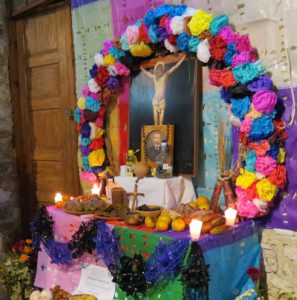
‘The sun is the source of energy; when man dies he blends into the earth and his energy feeds the sun. Do not mourn as the journey continues through the cosmos’, thus was the general belief in pre-Hispanic Mexico.
A phosphorescent carpet of zempasúchitl flowers (marigolds) leads the way to the altars. The offerings must include the four elements: water, earth, wind and fire. No offering is complete without them. Water, to quench the thirst after the long journey; bread and food, made with products earth provides; wind moves the colorful and cheerful chiseled paper; and, the purifying fire in the candles. At midnight, November 1st., the souls of departed children leave their relatives and are bid farewell with slow and rhythmical sounds of church bells. Adults are then welcomed after a long journey.
In Mixquic, southeast of Mexico City, the dead are honored in the cemetery and at night on November 2 the gloominess is gone when all candles are lit, the ceremony is known as “La Alumbrada,”. It is said that the Aztec Lady of Death, Mictecacíhuatl, roams the land and is visible only on November 1st and 2nd. Thus the millenary tradition is also alive San Luis Potosí, where one week earlier preparations begin, placing altars that will have tamales, chocolate, bread, chichiles, pemoles, atole, liquor; when dancers known as “huehues,” go to the cemetery to ask the dead for permission to honor them.
In Oaxaca preparations begin mid-October, gathering all the products that will be placed in the altars and on November 1st it is customary to present the family and friends of the departed ones with food that will also be part of the offerings in the altars. In this predominantly indigenous state, ethnic groups honor their dead dinking mezcal, along traditional music, dances, chants and mass: In Miahuatlán, en route to the coast Oaxaca, dead are paid so much respect that since October 15 cemeteries are filled with flowers and food. November 1 and 2 in Oaxaca, are solemn but also festive, not only for the dead but also for the living; a Carnival takes place with troupes wearing elaborate masks and costumes of devils and death, dancing though the streets. As it happens in many other regions, in Pomuch, State of Campeche, since October 26 tombs are cleaned, as it is believed that the dearly departed will not visit if the remains are not clean.
In the Maya tradition, death is just another phase of existence to look into the past and move forward onto another world.
The center of the universe was represented by the Yaxché, Ceiba, sacred and wise tree of life whose branches supported the thirteen levels of heaven and its roots were the nine levels of the underworld (Mitnal for the Maya of Yucatán and Xibalbá, for the Maya Quiché). Life was shaped by the Pixan, a gift from the gods, the vital fluid and the element that would travel to the underworld at the time of physical death. By a combination of pagan and religious rituals, the dead are “given permission” to abandon the great beyond and roam around looking for their homes, families and lands. Thus, when they find them, they are welcomed to the Hanal Pixan, the Meal for the Spirits.
This age-old special feast and ritual to the Dead, from October 31 to November 2, still takes place in the States of Yucatán, Quintana Roo and Campeche. The first day is dedicated to departed children who appear on the early hours and is known as U Hanal Palal; they are offered atole and boiled corn. The second day awaits another reception the U Hanal Nucuch Uinicoob, for the adults, when the offerings are more elaborate: maize tamales, poultry and pork meat with chili pepper sauce and spices (mukbil pollo, in Maya), chocolate, fruits, squash dessert, bread, beans, amongst others. And on the third day, a mass dedicated to the souls, usually in the cemeteries, U Hanal Pixanoob also known in some places as the Pixan Mass. Prayers are done in absolute peace for the dead and for those still living. The dearly departed come to eat, drink, share gifts, and once satisfied return to their eternal abode.
They will return next year, in a permanent cycle that keeps life and death closely linked. All the family participates in this feast; women are in charge of preparing the food and the altars with the offerings. Men dig holes, pib, in the ground for the mukbil pollo, a large cake-like dish made of corn, lard, stuffed with chicken, pork and spiced with tomato and chili pepper; then wrapped in huge banana leaves (like the tamales) and cooked underground or in the oven for around 2 hours. On the table covered with a white tablecloth with colorful embroidery, a cross, images of saints, pictures of the departed, yellow xpujuk (marigolds or flower of the dead) flowers, candles, incense, water, marzipan,
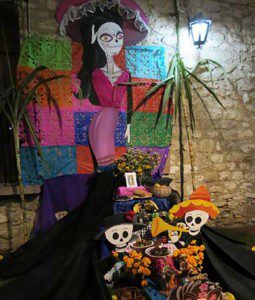
bread, mukbil pollo, Brazo de Reina (corn dough stuffed with annatto –axiote– chicken and buried in the pib), beans, relleno negro, chilmole, cacao, chocolate, bread, vaporcitos (steamed tamales); balche, the Maya liquor par excellence, xtabentún, sugar, salt, etc. Oddly as it may seem, unlike other central regions in Mexico, no skulls are part of the offerings. After the souls have been satiated, families and friends share the food. In the Yucatán peninsula an eight day (“ochovario”) celebration, Bix, continues as a less complicated repetition of the former one; homes light candles so the spirits may see their path as they leave. For several years now, the Hanal Pixan in Merida is also celebrated at the Plaza Grande with a large display of altars . The mysticism involved in this celebration is based not only in food offerings, but in the joy of knowing that the essence of the dearly departed visit the world of the living; a combination of nostalgia and happiness.
In his book the Labyrinth of Solitude, acclaimed Nobel Prize writer Octavio Paz described the particular relationship of the Mexican culture with death: The Mexican revisits death, jokes about it, caresses it, sleeps with it, celebrates it; it is one of the favorite toys and a steady love’. Many are the traditions and customs all around Mexico, where the religious mysticism of this 3000 year old celebration, is a magical reunion with the dead. The dead will again be missed but will return year after year, even if only for a few hours, to where, in life, was their home.
Día de los Muertos – Obra Maestra del Patrimonio Oral
e Inmaterial de la Humanidad (UNESCO)
‘El sol es fuente de energía; al morir, el hombre se fusiona con la tierra y su energía alimenta el sol. No se lamenten pues la travesía continua a través del cosmos’, esa era la creencia general del México prehispánico.
Un tapete de fosforescentes flores de zempasúchitl señala el camino hacia los altares. Las ofrendas deben incluir los cuatro elementos: agua, tierra, viento y fuego. Ninguna ofrenda está completa sin éstos. El agua para saciar la sed después del largo viaje; el pan y los alimentos, hechos de productos que la tierra da; el viento mueve los alegres y coloridos papeles picados; y, el purificante fuego en las velas. A la media noche del 1º de Noviembre, las almas de los pequeños difuntos dejan a sus familiares y son despedidos con los sonidos lentos y cadenciosos de las campanas de la iglesia. Entonces, se da la bienvenida a los adultos después de la larga travesía. En Mixquic, al sureste de la ciudad de México, se honra a los muertos en el cementerio, y por la noche del 2 de Noviembre se pierde el aspecto sombrío al momento de encender todas las velas, a la ceremonia se le conoce como “La Alumbrada” . Se dice que la “Dama de la Muerte” azteca, Mictecacíhuatl, deambula por la tierra y es visible sólo el 1º y 2 de Noviembre. De igual forma, sobrevive la milenaria tradición en San Luis Potosí, donde las preparaciones comienzan una semana antes, colocando los altares que tendrán tamales, chocolate, pan, chichiles, pemoles, atole, licor; es cuando los danzantes conocidos comohuehues acuden al cementerio a pedir permiso a los muertos para honrarlos.
En Oaxaca, los preparativos comienzan a mediados del mes de Octubre, reuniendo todos los productos que serán colocados en los altares, y el 1º de Noviembre se acostumbra llevar regalos compuestos de alimentos a la familia y amigos de los fueles difuntos, ya que éstos formaran parte de los altares. En este estado predominantemente indígena, los grupos étnicos honran a sus difuntos bebiendo mezcal, acompañados de música tradicional, bailes, cantos y misas. En Mihuatlán, camino a la costa de Oaxaca, tal es el respeto a los muertos que desde el 15 de Octubre los cementerios se encuentran llenos de flores y alimentos. El 1º y 2 de Noviembre en Oaxaca, son días solemnes pero también de fiesta, no sólo para los muertos sino para los vivos; se lleva a cabo un Carnaval con comparsas que portan máscaras sofisticadas y disfraces de diablos y de la muerte, bailando por las calles. Al igual que sucede en muchas otras regiones, en Pomuch, Estado de Campeche, desde el 26 de Octubre se limpian las tumbas ya que se cree que los amados difuntos no aparecerán si sus restos no se encuentran limpios.
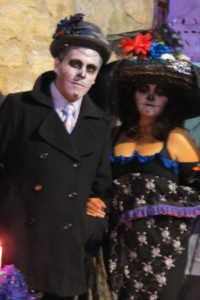
En las tradiciones mayas, la muerte es sólo otra fase de la existencia para ver el pasado y continuar hacia otro mundo. El centro del universo era representado por el sagrado y sabio Yaxché, la ceiba, el árbol de la vida cuyas ramas sostenían los trece niveles del cielo y sus raíces eran los nueve niveles del inframundo (Mitnalpara los mayas de Yucatán y Xibalbá para los mayas quiché). La vida era compuesta por el Pixan, un regalo de los dioses, el fluido vital y elemento que viajaría al inframundo al momento de la muerte física. En una combinación de rituales paganos y religiosos, a los muertos se les “otorga permiso” para abandonar el más allá y deambular buscando sus casas, familias y tierras. Así, cuando las encuentras, son bienvenidos al Hanal Pixan, la Comida de las Ánimas.
Esta antigua festividad y ritual especial a los Muertos, del 31 de Octubre al 2 de Noviembre, aún se lleva a cabo en los Estados de Yucatán, Quintana Roo y Campeche. El primer día se dedica a los niños quienes aparecen durante las primeras horas y se le conoce como as U Hanal Palal; se les ofrece atole y maíz sancochado. Al segundo día se espera otra recepción, el U Hanal Nucuch Uinicoob, para los adultos, cuando las ofrendas son más elaboradas: tamales de maíz, carne de aves y puerco con salsa de chile y especias (mukbil pollo en maya), chocolate, frutas, dulce de calabaza, pan, frijoles, entre otros. Y, el tercer día, una misa dedicada a las ánimas, por lo general en los cementerios, U Hanal Pixanoobtambién conocida en algunos sitios como la Misa Pixán. Los rezos se realizan en absoluta paz para los muertos y para los vivos. Los fieles difuntos llegan a comer, beber, compartir regalos, y una vez satisfechos, retornan a su eterna morada. Regresarán el próximo año, en un ciclo permanente que mantiene la vida y la muerte estrechamente vinculadas. Toda la familia participa en esta fiesta; las mujeres están a cargo de la preparación de los alimentos y de los altares con las ofrendas. Los hombres cavan huecos, pib, en la tierra para el mukbil pollo, un gran platillo similar a un pastel hecho de maíz, manteca, relleno de pollo, cerdo y condimentado con tomate y chile; luego es envuelto en enormes hojas de plátano (como los tamales) y se cocina bajo tierra o en el horno por aproximadamente 2 horas . Sobre la mesa cubierta con un mantel blanco de coloridos bordados, se colocan la cruz, imágenes de santos, fotografías de los difuntos, las flores amarillas xpujuk (caléndulas o flor de muerto), velas, incienso, agua, mazapán, pan, mukbil pollo, Brazo de Reina (masa de maíz rellena con axiote y enterrada en el pib), frijoles, relleno negro, chilmole, cacao, chocolate, pan, vaporcitos (tamales al vapor); balché, el licor maya por excelencia, xtabentún, azúcar, sal, etc. Aunque parezca extraño, a diferencia de otras regiones en México, las calaveras no forman parte de las ofrendas.
Después de que las almas se han saciado, las familias y los amigos comparten los alimentos. En la península de Yucatán, la celebración de ocho días (ochovario), Bix, continúa como una repetición menos complicada de la anterior; en los hogares se encienden velas para que los espíritus puedan ver su camino al partir. Durante varios años, el Hanal Pixan en Mérida también se celebra en la Plaza Grande con una gran muestra de altares . El misticismo que comprende esta celebración no sólo tiene como base las ofrendas de alimentos, sino la alegría de saber que la esencia de los amados difuntos visitan el mundo de los vivos; una combinación de nostalgia y felicidad.
El aclamado escritor ganador del Premio Nobel, Octavio Paz, en su libro El Laberinto de la Soledad, describió la particular relación de la cultura mexicana con la muerte: “El mexicano frecuenta a la muerte, la burla, la acaricia, duerme con ella, la festeja, es uno de sus juguetes favoritos y su amor permanente”. Muchas son las tradiciones y costumbres en todo México donde el misticismo religioso de esta celebración que data desde hace 3000, es una mágica reunión con los muertos. A los muertos se les extrañara nuevamente, pero regresarán año tras año, si tan sólo por unas horas, al lugar donde, en vida, fuera su hogar.
Otra fugitiva de la Ciudad de México. Mónica ha hecho de Cozumel su hogar definitivo. Desde su llegada en 1981, trabajo en turismo en todos los lugares habituales: hoteles, buceo, aeropuerto, ferries, hasta que se abrió la oportunidad de desempeñarse en su campo. Desde finales de la década de los años 70 Mónica ha estado traduciendo e interpretando, dedicándose plenamente a ello a partir de 1998, y ha asistido a extranjeros y locales de la Isla a establecer su residencia y sus negocios. Es traductora con gran experiencia, ávida historiadora y una gran fuente de tradiciones y leyendas locales.
- Mexican History 3 Kings Day - January 8, 2025
- 2025 Mexican National Holidays - January 3, 2025
- Mayan Weather Predictions - January 2, 2025
Another escapee from Mexico City, Monica has made Cozumel her definite home. Since her arrival -in 981- she worked in tourism in all the usual venues: hotels, scuba diving, airport, ferries, until the opportunity to practice in her chosen field grew. Since the latter part of the 70s Monica has been translating and interpreting, fully devoting herself to it since 1998, and has assisted foreigners and Island residents establish residence and businesses- She is a Translator with extensive experience, an avid historian and a great source of local lore and legends. Otra fugitiva de la Ciudad de México. Mónica ha hecho de Cozumel su hogar definitivo. Desde su llegada en 1981, trabajo en turismo en todos los lugares habituales: hoteles, buceo, aeropuerto, ferries, hasta que se abrió la oportunidad de desempeñarse en su campo. Desde finales de la década de los años 70 Mónica ha estado traduciendo e interpretando, dedicándose plenamente a ello a partir de 1998, y ha asistido a extranjeros y locales de la Isla a establecer su residencia y sus negocios. Es traductora con gran experiencia, ávida historiadora y una gran fuente de tradiciones y leyendas locales.
Rising Housing Prices Rents Luxury Tourism Royal Caribbean Quintana Roo.
Rising Housing Prices Rents Luxury Tourism Royal Caribbean Quintana Roo. The Housing...
CFE Underwater Electrical Cable Cozumel
CFE Underwater Electrical Cable Cozumel CFE Underwater Cable Set for March: More...
Mexico September Will Testament
Take Advantage of September & Update Your Will The Mexican Federal Government...
Cozumel Drugs Marijuana
Cozumel Drugs Marijuana Navy Officials Arrest 3 People Leaving Marina With...







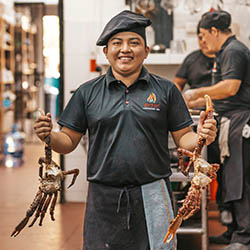



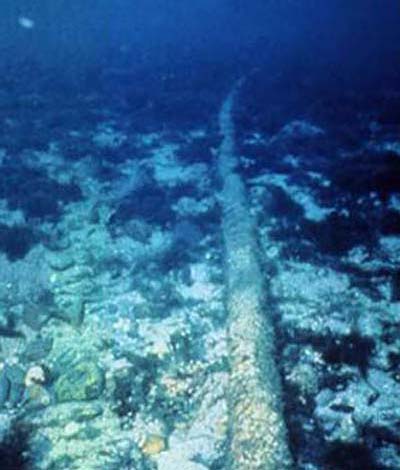
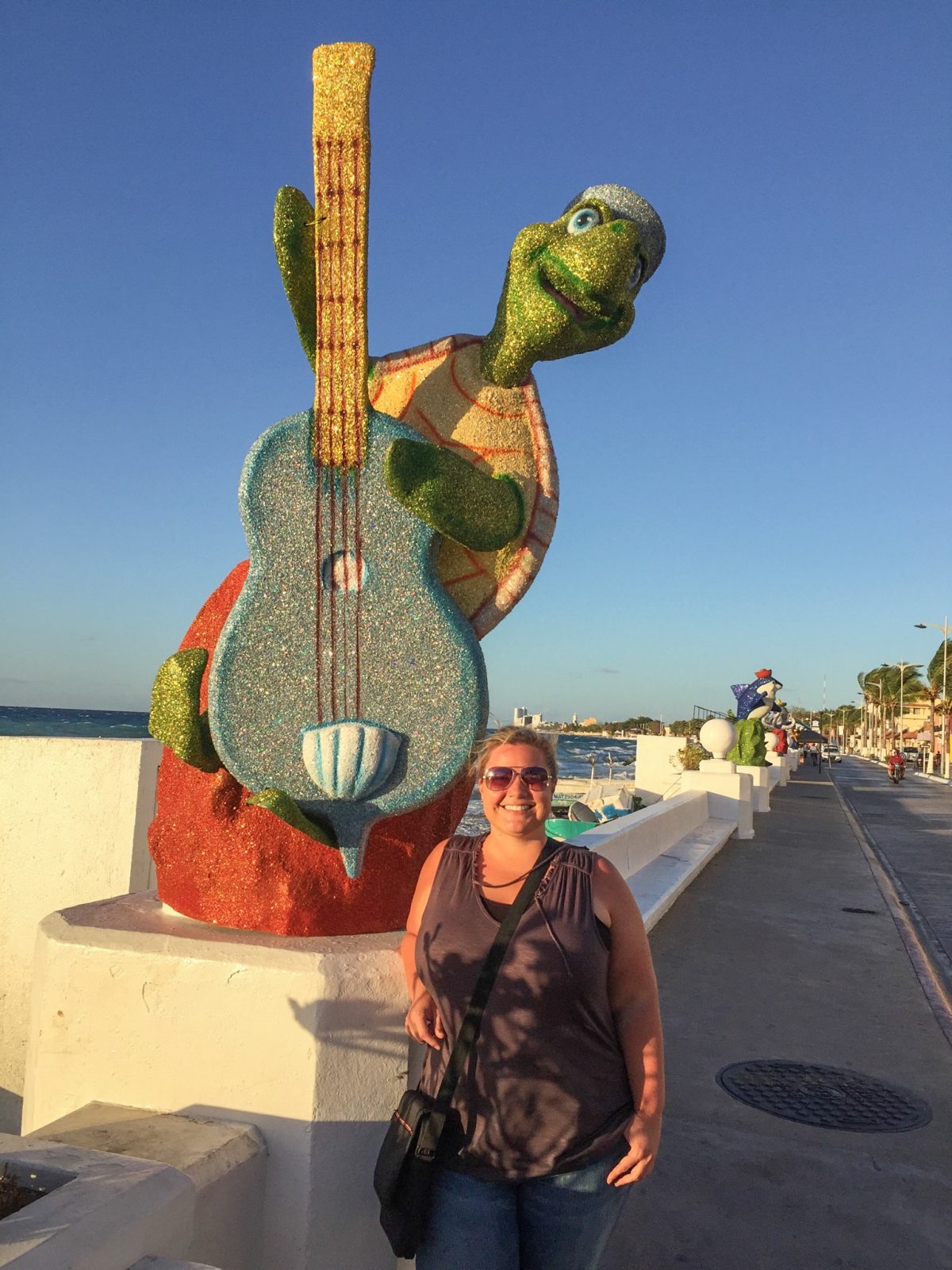




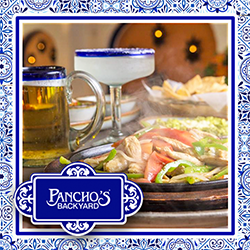


Leave a comment